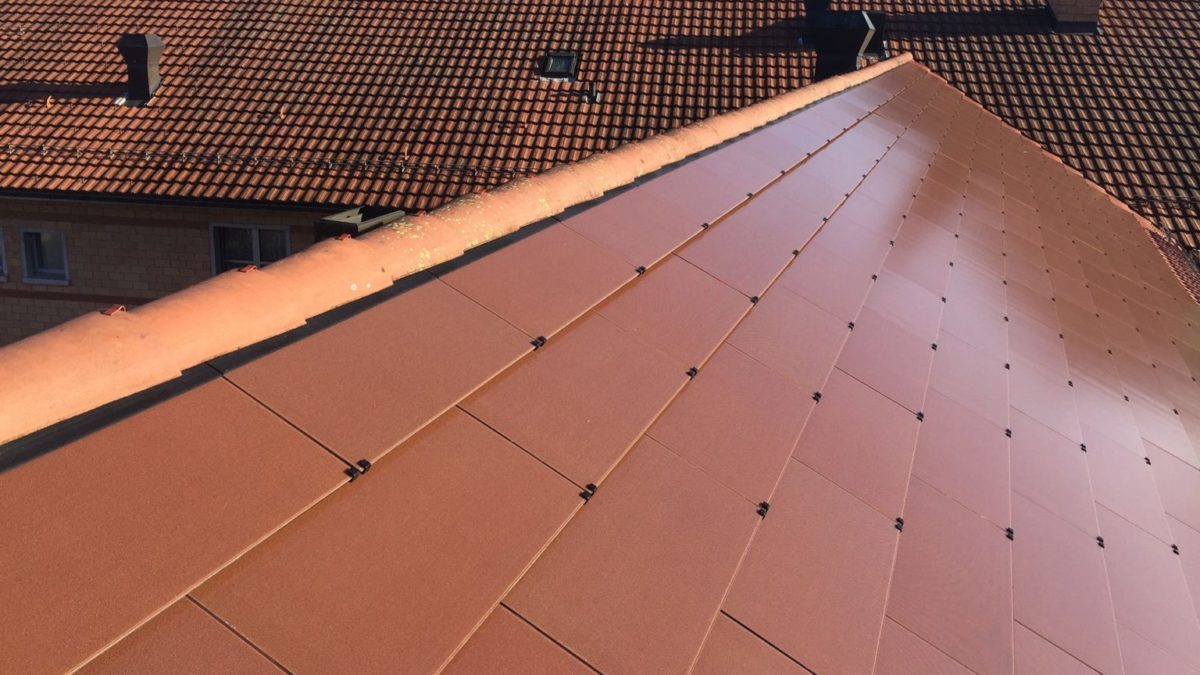From pv magazine International
Swiss manufacturer Megasol launched, last year, a photovoltaic tile that is claimed to be compatible with a wide range of roof tiles.
Megasol is offering three standard formats that can be combined with one another, as required. “Compatible means that a ‘Match’ solar module can replace one or more tiles in an existing tiled roof without any further adjustments,” explained Michael Reist, marketing manager at Megasol, to pv magazine.
The solar tile is not only compatible with the most common roof tiles, it is also available in different colors. The Full Black and Terra Cotta variants have proven to be popular optics and other individual colors could also be created. According to the manufacturer, the photovoltaic roof tiles could be freely designed for any architecture.
“It is also possible to give the Match solar modules an individual look using glass structures,” Reist explained. “Classic solar glasses or, for example, the Creek, Diamond, River or Wave glass surfaces can be used.” For this, Megasol was also awarded the international Red Dot Award design prize this year.
The photovoltaic roof tile is also suitable for various roof shapes. In addition to being used on tiled roofs, it can also be combined with clapboard-like roofs such as fiber cement shingles.

One reason why photovoltaic roof tiles are still more of a niche product is that their energy conversion performance is rather lower and, at the same time, they have higher costs compared to conventional rooftop panels. But technological advances do not stop at solar roof tiles either. According to Megasol, Match consists of glass-glass modules which also work as the roof tiles. The product works without an aluminum frame or plastic housing. Since there are several standard formats for each type of tile, the performance of the photovoltaic roof tiles also varies accordingly. According to Megasol, the two standard products have a power output of 22 and 55 W and its most-power product reaches 99 W. With the colored variations, performance losses are normal, but these also showed “good performance values,” the manufacturer continues.
In addition, the photovoltaic roof tiles have a high load-bearing capacity and resistance to hail protection. The Swiss photovoltaic manufacturer assumes a service life of up to 50 years and offers guarantees for up to 35 years.
The system consists of two components: the glass-glass solar module and a mounting hook. According to Megasol, the photovoltaic roof tile is also suitable for integration into existing tile roofs and the existing roof battens can be used. Each individual module has a plus and minus connector. With the long cables, the photovoltaic roof tile Match can be wired both horizontally and vertically, as the provider explained. The simple structure also allows a simple replacement if a photovoltaic roof tile is damaged.
The watt-peak prices for in-roof solar modules are higher than those of conventional panels but, at the same time, the photovoltaic tile also has a roof function. “With Match, not only a photovoltaic system but also a new roof is installed,” Reist went on to say. “If the costs for a new roof covering are deducted from a Match roof, the result is more or less the costs of a rooftop PV system.” If the longer service life of the glass-glass solar modules is also taken into account, compared to the use of glass-foil solar modules in conventional roof systems, the costs for a Match system over the operating time could be even cheaper.

In the recent past, Megasol has taken on yet another topic which is a big issue for many operators of photovoltaic systems – or rather their neighbors: the glare effect of solar modules. Objectively speaking, the actual glare effect of solar modules is significantly lower than that of large window fronts or skylights, according to the Swiss photovoltaic manufacturer, due to the solar glass used. However, the subjective perception of glare effects caused by solar modules is sometimes different. This is why the manufacturer developed the ZeroReflect surface which is claimed to have zero glare.
Megasol developed this special surface coating independently of its photovoltaic roof tiles. “Existing solar systems can also be equipped with ZeroReflect. The costs incurred can be many times lower than the potential expenses for anti-glare reports, court hearings, or even just for lengthy discussions in a possible neighborhood dispute,” said Reist.
*The article was amended on November 8 to reflect that the manufacturer’s name is Megasol, and not Megasolar as we previously reported.
This content is protected by copyright and may not be reused. If you want to cooperate with us and would like to reuse some of our content, please contact: editors@pv-magazine.com.









By submitting this form you agree to pv magazine using your data for the purposes of publishing your comment.
Your personal data will only be disclosed or otherwise transmitted to third parties for the purposes of spam filtering or if this is necessary for technical maintenance of the website. Any other transfer to third parties will not take place unless this is justified on the basis of applicable data protection regulations or if pv magazine is legally obliged to do so.
You may revoke this consent at any time with effect for the future, in which case your personal data will be deleted immediately. Otherwise, your data will be deleted if pv magazine has processed your request or the purpose of data storage is fulfilled.
Further information on data privacy can be found in our Data Protection Policy.